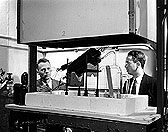Jay Forrester

|
principal papers hardware software keywords see also related subjects |
Achievement Developed magnetic core memory
Biography Jay Forrester was born in Nebraska in 1918 and grew up on a cattle ranch. His early interest in electricity was spurred, perhaps, by the fact that the ranch had none. While in high school, he built a wind-driven, 12-volt electrical system using old car parts -- it gave the ranch its first electric power. After high school, Forrester went to the University of Nebraska and then to graduate school at MIT. It was 1939. He was a research assistant at MIT's High Voltage Laboratory, transferring the next year to the new Servomechanisms Lab, which developed electric and hydraulic servomechanisms for gun mounts and radar. (A servomechanism is key to the automatic control of a mechanical device; it regulates the mechanism in response to feedback.) By 1944, Forrester was thinking of leaving the lab and going into business for himself. The lab director, knowing Forrester's talents, didn't want this to happen, and offered Forrester his choice of projects to head up. He chose a Navy-sponsored program to design computers for testing new aircraft designs. (Most computer development during World War II and the postwar period was funded by the military; the Army, for example, had sponsored the ENIAC project.) The Navy project evolved into the Whirlwind computer, and later into the SAGE air defense system. Forrester changed the Navy's initial plan for an analog computer to a digital system after seeing the ENIAC model. Most importantly, while working out problems with Whirlwind, Forrester designed a vastly improved method for storing memory. He refined magnetic core memory in 1949, and it would eventually be used throughout the computer industry.
Around 1949, the Navy was losing interest in Whirlwind and considered scrapping it. But that August, the Soviet Union detonated its first atomic bomb. Relations between the U.S. and its former ally had so deteriorated that this event inspired worry and alarm throughout the government. People in the military realized that computers would be essential in the defense of the country now that the USSR had the capacity to attack from afar. Whirlwind, as the Navy's most advanced computer, suddenly looked good again. Forrester implemented the development of the Semi-Automatic Ground Environment (SAGE) system from Whirlwind-based prototypes. In 1953, Forrester's magnetic core memory was added to the system. He left the project in 1956, when it was running smoothly through its final stages. SAGE began operation in 1958 and was used as an air defense system until the 1980s. Forrester now made a career change that at first glance was surprising. He became a professor at MIT's Sloan School of Management. But applying his engineering view of electrical systems to the field of human systems would break new ground. Forrester focused on concrete experimental studies of organizational policy. He used computer simulations to analyze social systems and predict the implications of different models. This method came to be called "system dynamics," and Forrester came to be recognized as its creator. It has been applied in a wide range of fields. In the 1970s, Forrester applied it to global problems, concluding that industrialization was as big a problem as overpopulation in upsetting global equilibrium. He published several books on systems dynamics, and has received numerous awards and honorary degrees.
ChronologyHonors and awards
|
![]()
| Last Updated on April 14, 2004 | For suggestions please mail the editors |
Footnotes & References
| 1 |
Courtesy ScienCentral Inc and the American Institute of Physics 1999 |
| 2 | |
| 3 |